False or lazy jacquard, unlike a simple ornament, is characterized by simple knitting patterns. In this case, the consumption of thread material will be minimal. Lazy Jacquard, as a popular knitting technique, is called "pattern with slipped loops".
Often, when knitting every 2 lines, you will need to adhere to the alternation of shades. The ornament will be formed when removing stitches of the previous line, which were made with yarn of a different tone. As a result, the finished product will have a neat appearance without broaches.
Necessary tools and materials
To work, you only need to prepare the thread material with knitting needles. Additionally, you may need scissors to cut the yarn, as well as a measuring tape to measure the dimensions of the knitted fabric.

Beginner knitters should give preference to medium-thick threads and tools. In this case, the size of the needles should be 3-3.5 mm, so that it is comfortable to work. When choosing thick tools, it will be difficult to grab the stitches, while such needles should be used freely.
If you do not have much experience in knitting, do not choose knitting needles made of bamboo, plastic or wood. In this case, the thread material will slide poorly on the tools, and for beginners, knitting needles can bend in their hands because they hold them with tension. It is best to use tools made of steel, because they are strong and smooth.
Lazy jacquard with knitting needles with removed loops is initially better to knit from cheap and simple thread material. Semi-wool or wool yarn that does not slip will do. In this case, the composition should not contain nylon, viscose or silk.
If you choose a slippery thread, the missed stitch will quickly unravel along with the rest of the loops, and you will have to knit the row again. Also, do not choose fluffy, mohair threads. This type of yarn will cling with pile, and it will be problematic to unravel the sample so that the material does not deform, does not become thin and does not become covered in lumps.
Schemes with description of works for beginners
Lazy jacquard with removed loops is suitable for creating a large number of different products. This pattern is in great demand among knitters, because there are no broaches on the back of the fabric.
At the same time, a knitted product is less susceptible to wear, unlike fabric made using the traditional jacquard knot technique.
False jacquard is suitable for knitting:
- mittens;
- women's and men's sweaters;
- cardigan;
- socks;
- sweaters;
- hats;
- scarf.
Chain
In the lazy jacquard technique, it is permissible to create a two-color ornament in the form of a chain. The pattern is suitable for creating the main ornament if you repeat the pattern in a certain rhythm, as well as for knitting the border. When making a pattern in the form of a chain, you need to change the shade of the yarn every 2 rows.
Step-by-step description of the scheme:
- Initially, dial a certain number of stitches, which will be a multiple of 6. Then knit 4-6 lines using the stocking stitch technique. Then you can proceed to the design of the pattern.
- In the 1st row, knit 5 front stitches, after 1 loop remove, the yarn should be behind the fabric. Repeat the elements with alternation until the end of the line.
- In the 2nd row, remove 1 stitch (the yarn should be in front of the fabric) and knit 5 purl loops. Repeat alternating to the end of the row.
- Row 3 consists of 1 slip, 3 knits, 1 slip and 1 knit. After each slip, the yarn should be behind the work. Alternate the loops until the end of the row.
- Row 4 consists of 1 purl, 1 slipped, 3 purl and 1 slipped stitch. After each slip, place the yarn in front of the fabric. Alternate stitches until the line is complete.
- In the 5th row, knit 2 front loops, then remove 1 stitch (the thread should be behind the fabric) and make 3 front elements. Continue alternating until the end of the row.
- In the 6th row, make 3 purl stitches and remove 1 loop (the yarn should be in front of the work), knitting 2 purl elements. Continue alternating to the end of the row.
- Knit row 7 in the same way as row 3.
- Row 8 coincides with row 4.
- Row 9 is similar to row 1.
- Row 10 is designed as row 2.
Zigzag
Lazy jacquard with knitting needles with removed loops can be decorated with a zigzag pattern, which is in great demand among knitters. Thanks to a simple diagram with a description, this option is suitable not only for experienced but also for beginners.
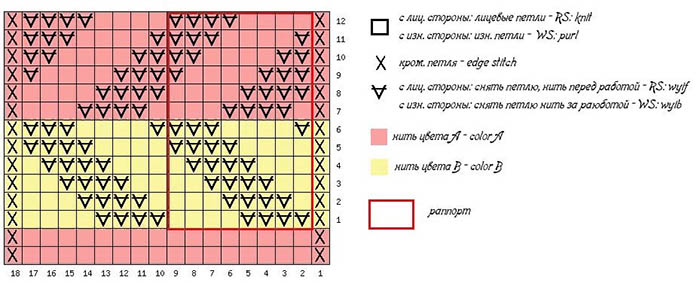
Abbreviations for designating loops:
| Name | Reduction |
| Facial | persons. p. |
| Purl | purl p. |
| Loop | p. |
Step-by-step description of the work:
- Initially, dial the required number of sts, which will be a multiple of 6.
- In the 1st row, remove 1 st, placing the yarn behind the fabric. Knit 2 front sts. Alternate loops to the end of the row.
- 2 and all other even rows are designed according to the pattern, removing stitches where necessary. The yarn must be behind the fabric.
- Row 3 consists of 1 knit stitch, 1 slip stitch, 3 knit stitches and 1 slip stitch. After each slip stitch, the yarn should be behind the work. Repeat alternating until the row is finished.
- Row 5 consists of 2 knit stitches, 1 slipped stitch, 1 knit stitch, 1 slipped stitch and 1 knit stitch. With each slip, place the yarn behind the work. Alternate stitches until the row is complete.
- In the 7th row, initially remove 1 st, then knit 2 front sts, then remove 1 st again and knit 2 front sts. With each removal, the yarn should be behind the product. Continue alternating until the end of the row.
- In the 9th row make 1 front st, remove the next st, make 3 front sts again and remove 1 st. After removing the stitch, place the yarn behind the fabric. Repeat the elements with alternation until the end of the row.
- Row 11 consists of 2 knit stitches, 1 slipped stitch, 1 knit stitch, 1 slipped stitch and 1 knit stitch. After each slip, the yarn should be behind the work. Repeat alternating until the row is finished.
Chicken foot
Often the "Chicken Foot" pattern needs to be made using the traditional jacquard technique. However, for speed and simplification of the knitting pattern, this ornament can be made using a false jacquard with removed stitches.
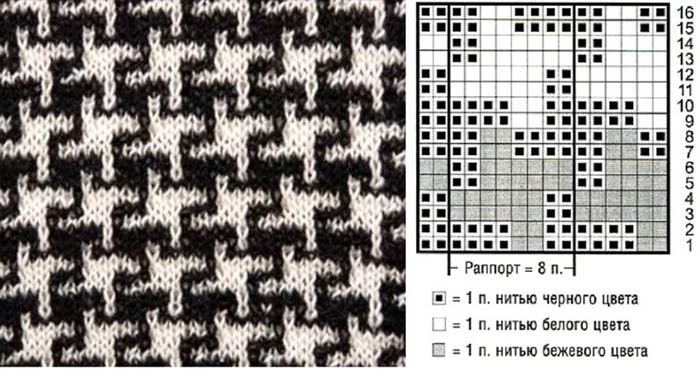
In order for the pattern to be clearly visible on the canvas, it is permissible to use 2 types of yarn of white and black shades. The main color of the product should be black, the pattern should be knitted with white threads.
Step-by-step description of the scheme:
- To create a rapport, make a set of loops, the number of which should be a multiple of 6.
- Row 1 consists of 1 slip stitch (yarn should be behind the product) and 5 knit stitches. Continue alternating until the end of the row.
- 2 and all other even lines do according to the ornament, removing stitches without knitting. The yarn should be in front of the work.
- Row 3 consists of 5 knits and 1 slipped element, with the yarn behind the fabric. Alternate repeating the loops until the end of the row.
- Row 5 consists of 3 slipped, 1 knit, 1 slipped and 1 knit stitch. After each slip, be sure to place the yarn behind the work. Alternate until the end of the row.
- Row 7 consists of 3 knits, 1 slip and 2 knits (alternate until the end of the row). With each slip, the thread should be behind the fabric.
- In the 9th row, make 2 front loops and remove 1 stitch, placing the yarn behind the fabric. Then knit 3 front elements. Repeat the alternation until the end of the row.
- In the 11th row, knit 3 front stitches, after 3 loops remove, leaving the material behind the canvas. Alternate this step until the line is finished.
Two-color stripes
Two-color stripes, decorated with lazy jacquard, are suitable for creating children's clothing. Also, such a pattern will look beautiful on women's things, a pillow, a blanket and a plaid. This pattern consists of 2 stripes of different shades.
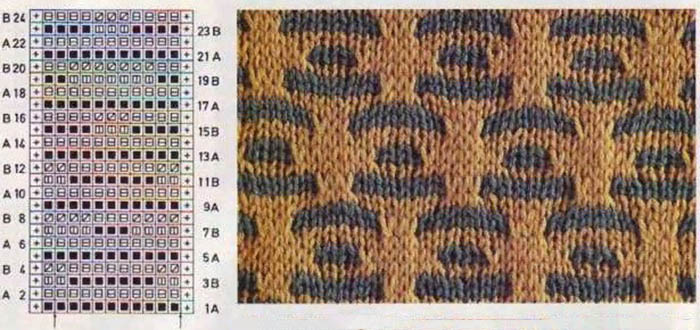
If desired, it is permissible to use several different colors. When choosing this technique, the work will not take much time and effort, and there is no need to spend a large amount of thread material.
Step-by-step description of knitting:
- Make a rapport from the required number of loops, which will be a multiple of 4.
- In the 1st row, initially knit 2 front loops, after 1 stitch remove, placing the yarn behind the fabric. Then repeat to the end of the line with alternating pattern of 5 front, 1 removed (the thread should be behind the product) and 2 front elements.
- In the 2nd row, all stitches are designed according to the pattern. When removing loops, place the thread material behind the fabric.
- In the 3rd row, knit 5 face stitches. Then, with alternation to the end of the row, repeat the pattern of 1 removed and 5 face loops. When removing, the yarn must be behind the product.
Springs
In the lazy jacquard technique, it is permissible to create various ornaments. For example, a pattern in the form of springs with curls looks unusual and beautiful. This knitting option requires the use of 2 shades of yarn, which must be alternated through a row.

Step-by-step description of the work:
- Cast on a pattern of loops, the number of which is a multiple of 6.
- In the 1st row make 2 front stitches. Then repeat to the end of the row alternating the pattern of 1 removed (the yarn should be behind the fabric) and 5 front loops.
- All even rows, starting from the 2nd row, are designed according to the pattern. When removing stitches, the thread must be behind the work.
- Row 3 consists of 1 knit, 1 slip, 3 knits, 1 slip, 1 knit and 1 slip. After each slip, the yarn should be behind the fabric. Alternate the loops until the row is finished.
- In the 5th row, initially knit 4 front stitches. Then remove 1 loop (the thread should be behind the product) and make 5 front stitches (alternate until the end of the row). To complete the stitch, remove 1 element, placing the yarn behind the fabric, and knit 3 front loops.
- In the 7th row make 1 front loop. Then remove 1 stitch, the yarn should be behind the work, knit 1 front element and remove again, while the material should be behind the product, then make 3 front stitches (alternate until the end of the row). To finish the line, remove 1 element, leaving the yarn behind the fabric.
- Row 9 consists of 1 slip stitch and 5 knit stitches (alternate to the end of the row). Then slip 1 stitch again and make 1 knit stitch to finish the row. With each slip, place the yarn behind the work.
- Row 11 includes 3 knit stitches, 1 slipped stitch, 1 knit stitch, and 1 slipped stitch (repeat alternating to end of row). To close the row, knit 2 knit stitches. After slipping the stitches, the yarn should be behind the garment.
Brick
Lazy jacquard with knitting needles with removed loops allows you to create a pattern in the form of rectangles on the fabric. The peculiarity of this ornament is that initially in the 1st row the figures are placed sequentially, after each rectangle in the new row will be between the two upper figures.
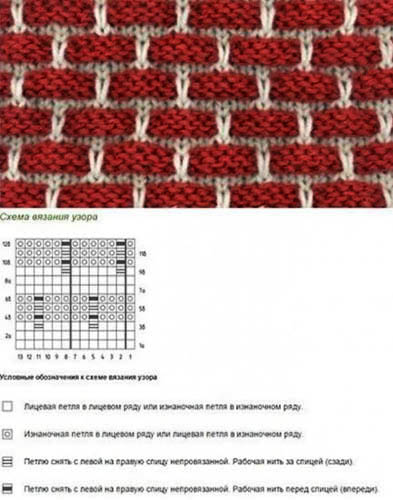
You can use any shade of yarn for knitting. In this case, you need to consider that 2 rows need to be knitted in one color, 4 rows - in another. The alternation of shades should be until the end of knitting.
Step-by-step description of the scheme:
- Make a rapport so that the number of stitches is a multiple of 6. Additionally knit 2 edge loops.
- Row 1 consists of front elements.
- 2nd row, make purl stitches.
- Row 3 consists of 3 knit stitches, 1 slip stitch (yarn should be behind the knitting) and 2 knit stitches. Alternate loops until the end of the row.
- Row 4 consists of 2 knits, 1 slipped (the material should be in front of the work) and 3 knits. Continue alternating until the end of the row.
- Row 5 consists of 3 purl, 1 slipped (the material should be behind the fabric) and 2 purl loops. Repeat the pattern with alternation until the end of the line.
- Knit row 6 in the same way as row 4.
- Row 7 corresponds to row 1.
- Row 8 is similar to row 2.
- Row 9 consists of 1 slip stitch and 5 knit stitches. Alternate until the row is finished. The yarn should be behind the work with each slip.
- In the 10th row, knit 5 front stitches, after 1 loop remove, leaving the yarn in front of the fabric. Continue alternating loops until the end of the line.
- In row 11, make 5 purl stitches and remove 1 element, leaving the yarn behind the fabric. Continue alternating until the row is finished.
- Row 12 is done in the same way as row 10.
Rainbow
To knit a rainbow ornament using the lazy jacquard technique, it is permissible to use 2, 3 or 4 shades of thread material. Everything will depend on the design of the clothes. In this case, the pattern of the ornament will not change. The first 4 lines must be decorated with one shade, then you need to change the tone every 6 lines.
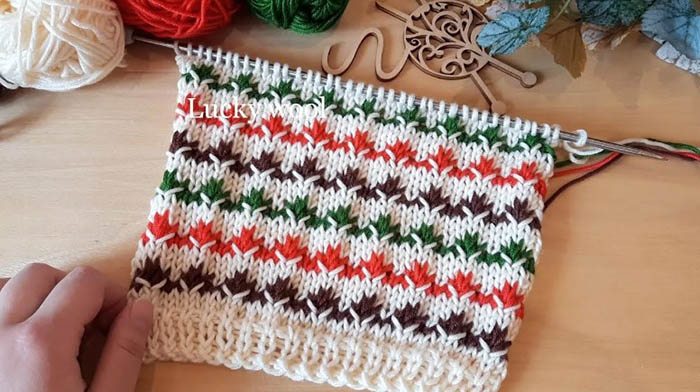
Step-by-step description of the work:
- Make a rapport so that the number of stitches is a multiple of 4. Additionally, design 2 edge elements.
- Rows 1 and 3 consist of 2 front and 2 back loops. Repeat alternating stitches until the end of the rows.
- Rows 2 and 4 are designed according to the pattern.
- In the 5th row, remove 2 stitches, leaving the yarn behind the fabric, and knit 2 front loops. Continue alternating until the row is finished.
- In the 6th row, knit a pattern of 2 purl and 2 removed elements with alternation to the end of the row. With each removal, the yarn should be in front of the fabric.
- Row 7 consists of knit stitches.
- In rows 8 and 10, knit a pattern of 2 purl and 2 front stitches alternating to the end of the rows.
- In the 9th row, make 2 purl and 2 front loops. Alternate the elements until the end of the row.
- Row 11 consists of 2 knit stitches and 2 slip stitches, alternating until the end of the row. The thread material should be behind the work.
- In row 12, remove 2 loops, leaving yarn in front of work, and knit 2 purl stitches. Alternate until the end of the row.
- In row 13, all loops should be knit.
- In rows 14 and 16, knit a pattern of 2 front and 2 back stitches alternating to the end of the rows.
- Row 15 consists of 2 front and 2 back elements, alternating until the end of the row.
- Continue knitting, starting from rows 5 and up to 16. Every 6 rows, be sure to change the shade of the threads.
Snake
Lazy jacquard with knitting needles with removed loops allows you to create not only simple, but also complex patterns. For example, you can make a pattern in the form of a snake. For knitting, you need to prepare two types of yarn in brown and gray shades. After every 2 rows, you need to change the color. Initially, you should start with a brown shade.
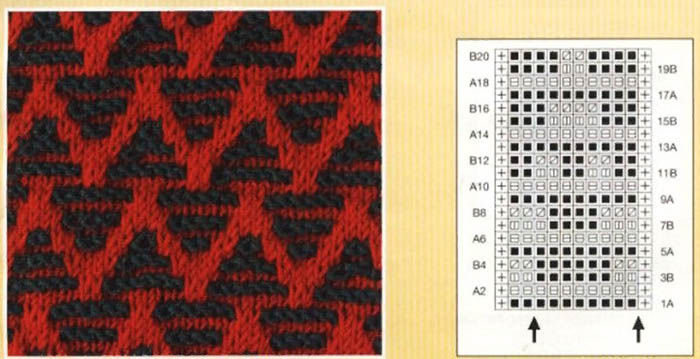
Step-by-step description of knitting:
- Cast on a number of stitches that is a multiple of 4. Additionally, make 2 edge loops.
- Row 1 consists of 3 knits and 1 slipped element, alternating to the end of the row. When slipping, the yarn should be behind the work.
- Row 2 consists of 1 slipped (the thread should be in front of the fabric) and 3 purl stitches, alternating until the end of the row.
- Row 3 consists of 2 knits, 1 slipped (thread should be behind the work) and 1 knit, alternating until the end of the row.
- In the 4th row, make 1 purl loop, then remove 1 stitch, leaving the yarn in front of the fabric. Then knit 2 purl loops. Continue alternating until the end of the line.
- Row 5 consists of 1 knit stitch, 1 slip stitch and 2 knit stitches, alternating until the end of the row. After slip stitch, the thread should be behind the work.
- Row 6 consists of 2 purl, 1 slipped (yarn should be in front of the fabric) and 1 purl elements. Alternate loops until the end of the row.
- Row 7 consists of 2 knit stitches, 1 slip stitch and 1 knit stitch. After slipping, the material should be behind the work. Alternate loops until the end of the row.
- In the 8th row, knit 1 purl loop, remove 1 stitch and leave the thread in front of the work. Then make 2 purl elements. Alternate stitches until the end of the row.
Secrets for Beginners
Secrets for Beginners:
- When making lazy jacquard, you cannot use yarn of different shades in one row. In this case, the process should take place from one skein of thread. You need to change the shade every 2 lines. It is by removing stitches in certain areas that the pattern will be created.
- It is best to use threads of the same diameter so that the pattern is beautiful and clear. As a result, the pattern will be uniform, and the background shade will smoothly transition into the details of the pattern.
- Before knitting the main fabric, it is necessary to make a sample using expensive material. In this case, it is recommended to knit at least 2 rapports, close the stitches, wash the fabric in warm water and dry. Only after all the manipulations can you try on the sample and calculate the stitches for large clothing.
Lazy jacquard with removed loops is considered a convenient and simple technique, thanks to which it is permissible to knit a large number of different products, for example, a phone case, things for dolls, a blanket or clothes. At the same time, the pattern can consist of several shades of yarn, which allows you to create beautiful color transitions.
Video about knitting
